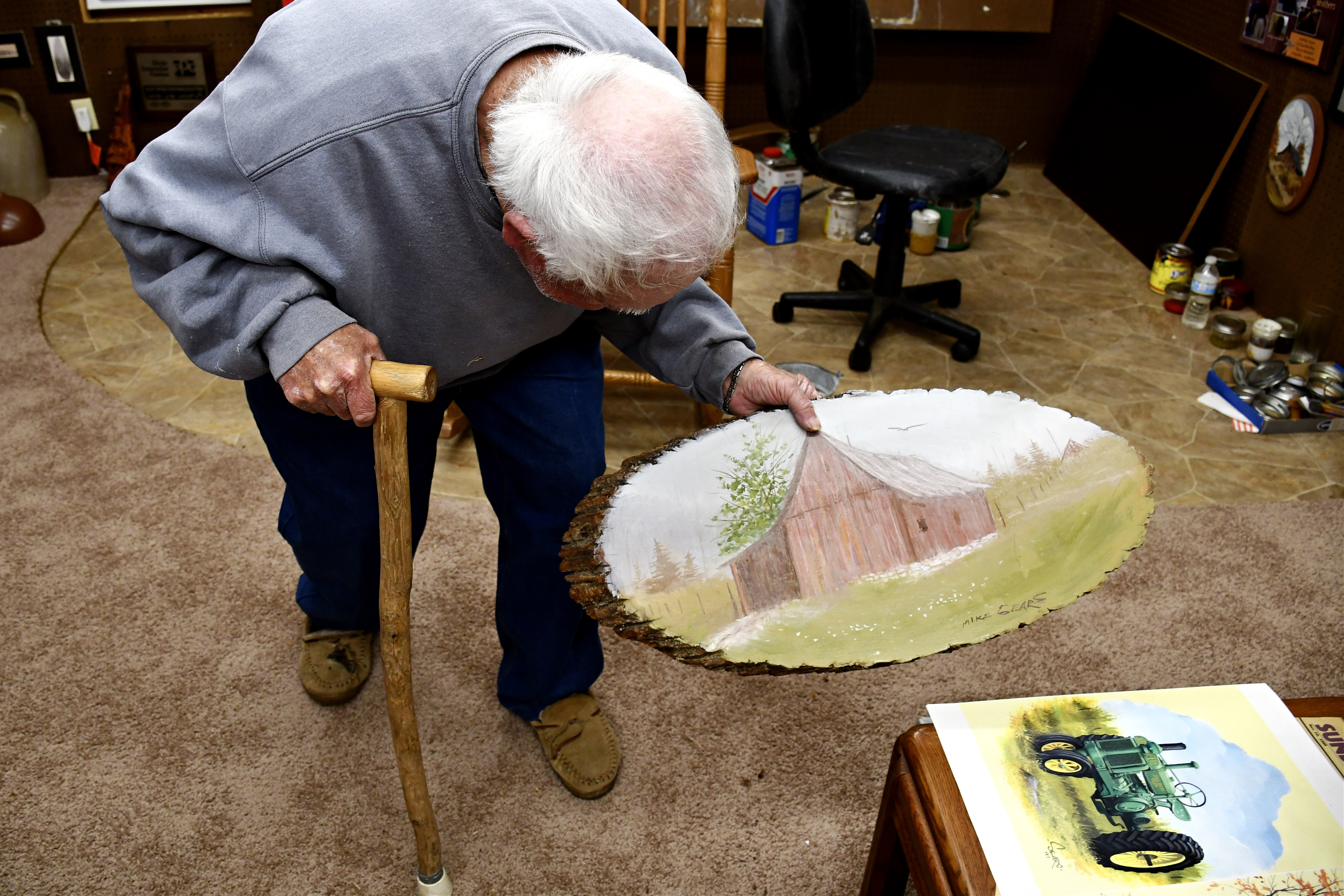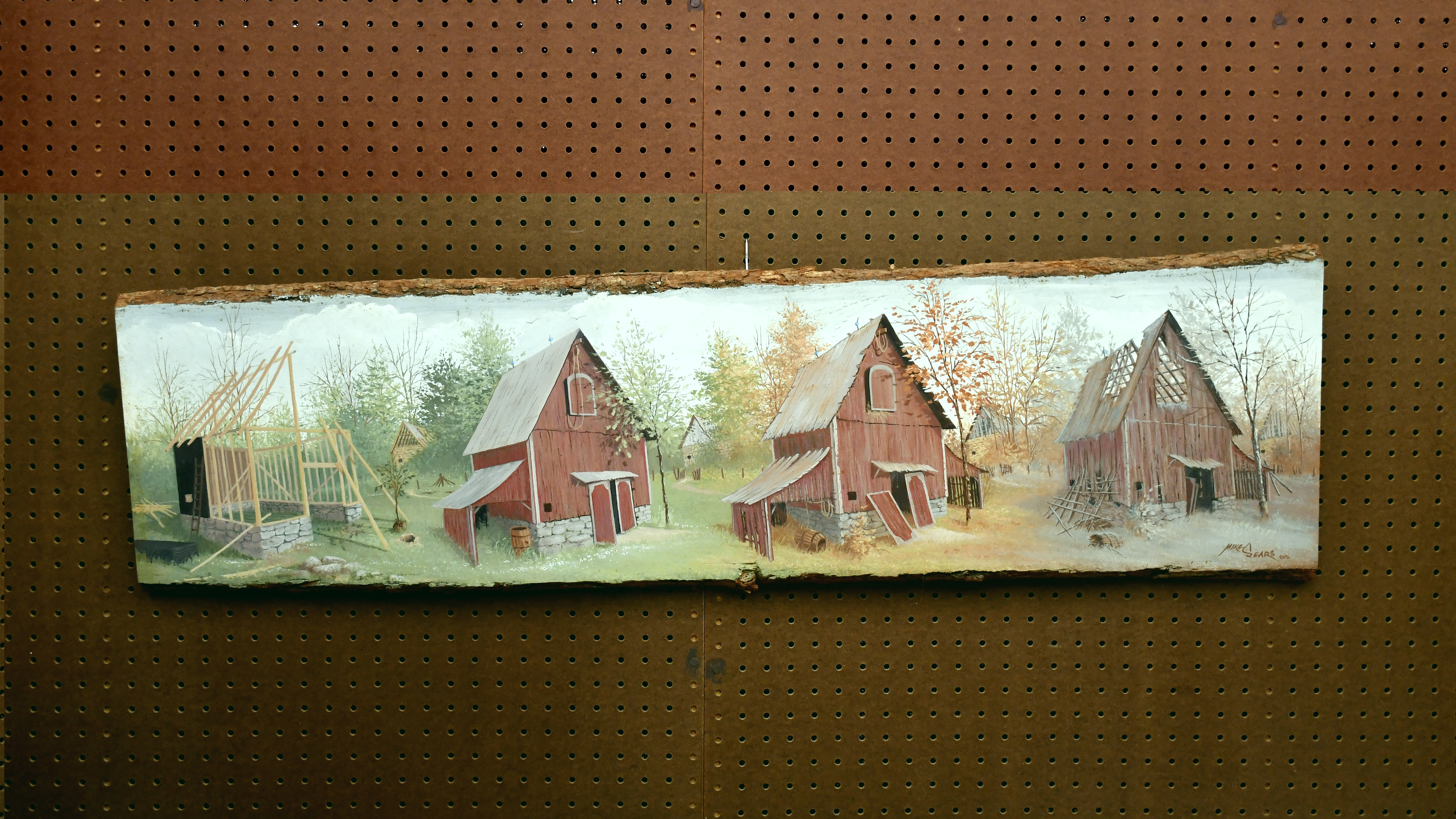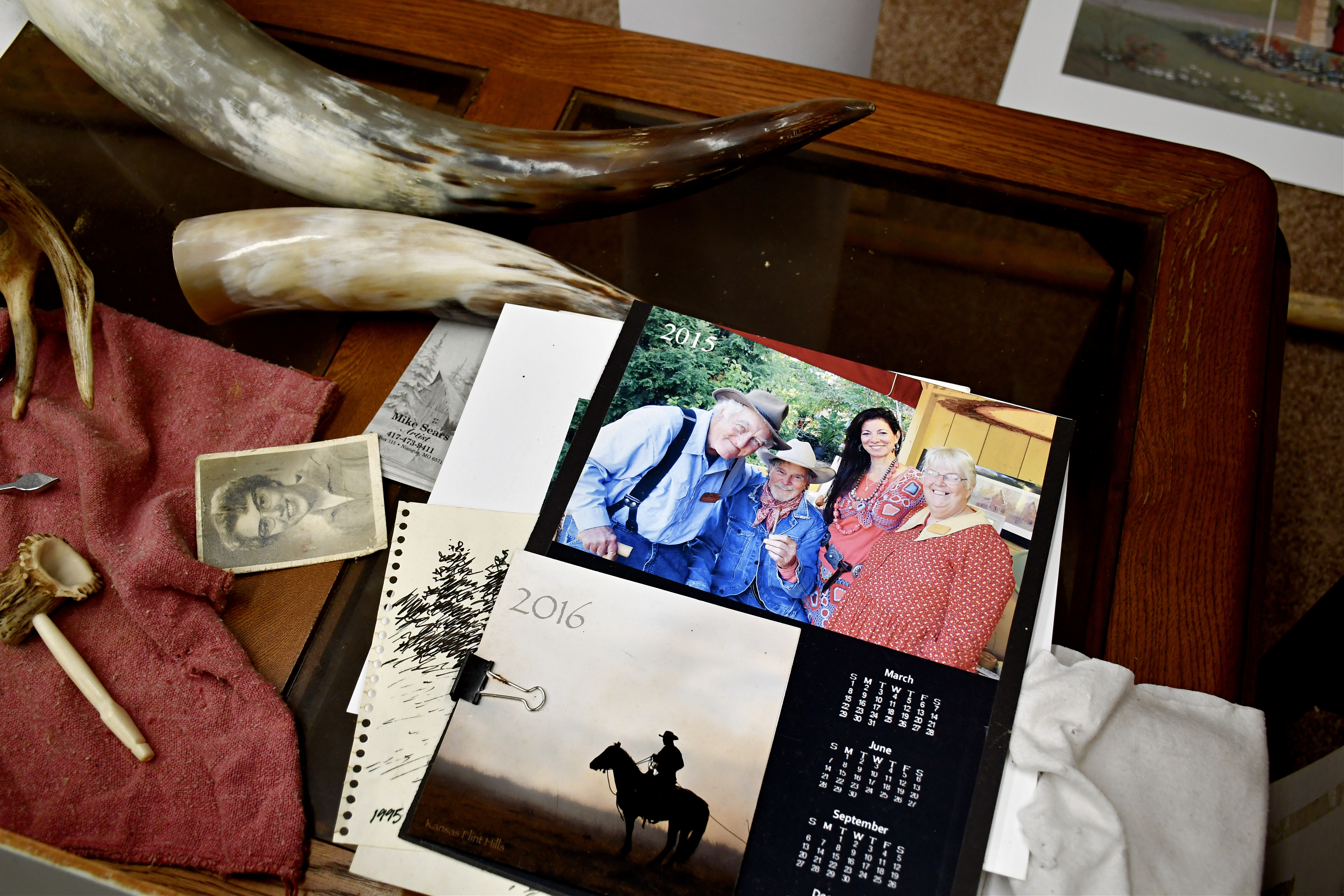NIANGUA — Mike Sears doesn’t paint with a picture on the tip of his brush. Instead of expectation, his work is guided by the world’s beauty, strokes that his heart tells his hands to make — and gratitude for what he’s able to do.
Despite the ravages of advanced Parkinson's disease — which now includes double vision — he still paints and has developed a community of fans from his many years of being an exhibitor during Silver Dollar City’s fall craft festivals. Mike’s work has also raised more than $500,000 for charity in his home state of Indiana, he says, where it has seemingly reached collectible status.
“I never had a lesson in my life,” he said from where he now lives near Niangua. “People were asking me how to do things now, and what I tell them is, ‘I won’t teach you how to do them, but I’ll let you sit back there and watch me.’”
From across the kitchen table, wife Sue Sears chimes in.
“He thinks it’s an easy thing. It’s not — I can’t sit down and paint.”
The Searses have lived in rural Webster County for more than 20 years. They made the move to be closer to family, choosing to settle along a rural route where it’s still the norm to know neighbors who drive by.
With rolling hills, trees and barns around each twist in the road, it’s like they’re tucked away in a real-life version of the pastoral paintings Mike creates.

That work began many years before the move. Mike was only a teenager when he began painting back home in Indiana. It wasn’t scenic scenes then, though: it was cars to which he began adding pinstripes.
He showed talent and promise, so much so that it blossomed into painting show cars as a career.
Despite Mike’s success, at one point he decided to supplement his income with other work, which led him to a print shop. He ultimately worked so much that the shop said he had to choose — cars or them — and the decision was simple. He chose cars.
“They knew he’d slept on his lunch hour, so they finally said, ‘Do you want to print or do you want to paint?’” Sue said. “They fired him but he stayed another six weeks. They didn’t make him go home. It’s one of those firing jobs at the moment they meant it, but they didn’t an hour later.”
It was that fact that changed Mike’s entire life by sending him home at a time he wasn’t formerly there.
“I turned the radio on, just to have some noise, and they were advertising an auction,” he said of a day in the 1970s. He wondered if maybe he could donate a piece of artwork — even though he’d never painted artistically before.
“I thought, ‘Why not?’ So I started painting artwork,” he said. “Never did it before in my life.”
Mike painted a small stoneware jug to donate for the auction, becoming the first of many items he’s contributed over the years.
“Once you get involved, you cannot quit,” Mike said of the event. Today, it’s grown into a 48-hour telethon known as We Care and supports a variety of nonprofits serving the Kokomo, Indiana, area. “I’ve been down here 23 years, and we haven’t stopped donating.”
In addition to the items Mike contributes, others come from people who have purchased his work in the past and give them back to be sold again.
“Now they’re bringing as much money now, if not more, than they did the first time they sold,” Sue said. “His work is getting double the money because they’re re-donating. We figure in the 40-some years he’s donated, it’s probably about half-million dollars he’s raised.”
A simple line in a news story about the event from 2021 speaks to Mike’s significance: “The biggest items donated so far were two dirt bikes and paintings from Mike Sears, a beloved local artist who now lives in Missouri.”
In the late '90s, one of his works was even used to create 2,000 puzzles that were sold to benefit the organization.
“I’m glad they asked me,” he said in a 1999 news article about working with the telethon. “I’ve always tried to help any way I could, and painting is the only way I can contribute.”
While subjects vary, Mike generally doesn’t have a picture in mind when he begins to paint. The likes of barns, flowers and trees gradually come to life as he works, which are created on wood. Sometimes, basswood provides the background, while at other times it’s high-quality plywood.
“It comes from Wisconsin. We have to call our supplier and he sends it to us,” noted Sue of the bark-lined basswood. “My brother cut out (the cutting boards) before he passed away. The plywood ones, a man cut for him before he passed away. So we’re running out of those things, but we can get this.”
After preparation, which includes sanding and sealing, Mike gets to work with a newspaper as his pallet — and outdoor, oil-based enamel sign paint on his brush. He still uses the paint that he had available at his start.
“I can make any color there is out of those nine colors — and that’s not bragging,” he said.
The images created through his self-taught skill feature scenes, but, at times, also convey deep symbolism.
An example hangs on the wall of his shop, showcasing a barn in four frames. As expected, the images take it through spring, summer, fall and winter — but in addition to the changing outdoor adornments, the seasons also depict the barn’s lifetime.

Mike began selling his work at Silver Dollar City shortly after the couple relocated to the Ozarks. By that time, his Parkinson’s diagnosis made it difficult to work with cars and he began to transition to artwork full-time.
The Searses were investigating options for locations to sell his artwork in Branson when the theme park was suggested as a possibility. After submitting an application, they were invited to attend and have been again and again ever since.
“Last year was our 20th year. It’s our 22nd year, but everybody lost two years,” Sue said, referring to the pandemic. “What was amazing is that people would come — some would say, ‘I saw you were on the computer list and we made sure to get here to see you.’ Others would say, ‘Boy, you’ve missed two years.’
“I told Mike, ‘How do they know we missed two years without knowing that they cared about us?’ There’s just so many wonderful people at the City to help.”

Those connections led to moments with Jack Herschend, one of the park’s founders, Brad Thomas, its general manager, and other artists, including painter Buck Taylor. Once character Newly O’Brian on the TV show “Gunsmoke,” Taylor more recently has shown his watercolors at Silver Dollar City.
“Buck Taylor comes up to us and spends time with Mike,” said Sue. “This year he came up three times because he was asking Mike questions about how to do something with a paintbrush. ‘Newly’ is a painter, but he needed some help, and Mike showed him how to paint.”
“I didn’t even charge him,” Mike joked.
Another major moment of community came to light a few years ago, but it didn’t take place at the park. It happened one season when Mike’s wood molded due to conditions inside his shop, which didn’t have a concrete floor. To make the wood usable, he had to spend significant time and energy cleaning it. When folks at the City found out, they decided that couldn’t happen again.
Unbeknownst to the Searses, a collection was taken up to help install a concrete floor in their shop. Then, one day when they were there at the festival, a crew from Silver Dollar City traveled to their Niangua home to install it.
“He knew nothing about it. I knew because I had supplied the keys,” said Sue. “Our daughter was here, and they went up to Hannah’s (the local gas station) and had lunch and she had ice and drinks for them, and a bathroom.
“That was on a Monday, and on Wednesday they all came to our booth along with lots of other people. They said, ‘Mike, turn around here.’ They showed him some photos — he didn’t know what he was looking at until our granddaughter was standing in the barn, and he realized it was his barn.”
The team even built a ramp outside so that if Mike required a scooter, he’d still be able to enter the building. Later, they came back to add a railing to the ramp.
“This was priceless.”
A tag on the framed photo says the same.

Years of advancing Parkinson’s have made painting more difficult, but Mike has persevered. It’s easier to work after taking his medication, which lessens some symptoms for a period of time. He also credits wearing a wellness bracelet with drastically reducing tremors that formerly forced him to shake uncontrollably. Yet one symptom is not alleviated by those techniques: double vision.
While that has been a factor in doing slightly less detailed work on his paintings, even that has not kept him from creating — both images and metaphors for life.
“You just have to work with what you’ve got,” he said in an Indiana news article in 1999. “Do what you can because that’s all you can do.”

